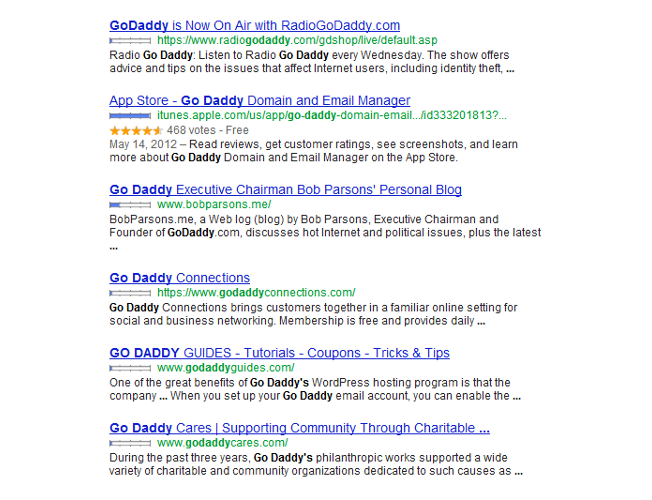Online reputation management is something that most people and businesses only think of when they need it. And when they need it is when disaster has struck – a negative review about their business, a negative blog post about their products, or a negative record about themselves surfaces online.
The thing to keep in mind is that online reputation management is one of those things that works better if you implement it before you actually need it. The following are ways to build a positive online reputation before you need it or start building positive online properties to outrank negative news and reviews.
Own Your Own Website
Your first goal for creating a positive online image is having a website. Chances are, you already have one for your business like yourbusiness.com. Be sure to also protect your personal brand by having one for your own name, i.e. firstnamelastname.com. Websites with an exact business or person’s name in the domain generally rank first when someone searches for the name. If you have a website you control at #1 in search results, it will get the most amount of clicks and prevent most people from continuing to look through the rest of the search results.
Own Related Domains
If you want to take it to the next level, build up some other domains for your business or yourself. Hosting companies are notorious for having negative information pop up in search results from bad reviews to anti-their-company groups. GoDaddy tackled this by creating a crop of additional websites with their brand name in the domain.
These websites that focus on their online radio, social network, tutorials, and charity rank right below their main website, Wikipedia page, and Twitter profile which makes it hard to get anything else that high up on the first page of search results for their name.
Comcast has a similar thing going, except in their case, they use subdomains.
Any business can do something similar by creating separate site for the following:
- Your blog such as blog.yourbusiness.com or yourbusinessblog.com.
- Your customer support such as support.yourbusiness.com or yourbusinesssupport.com.
- Your store such as store.yourbusiness.com or yourbusinessstore.com.
- Your main products such as product.yourbusiness.com or yourproduct.com.
- Your apps such as apps.yourbusiness.com or yourbusinessapps.com.
Start Multiple Blogs
Your main personal or company blog doesn’t have to be your only blog. Thanks to Google+ authorship and Google Direct Connect, you can tell Google a blog on any topic is related to you.
Here are two great examples. Danny Sullivan is well known for being the editor-in-chief for Search Engine Land. If you search for him, you’ll also find his personal blog named Daggle. It comes up in search results for his name simply because he put Danny Sullivan’s Personal Blog in the title of the homepage and connected it to his Google+ profile.
Another example was shown in the GoDaddy image above. Bob Parsons, founder of GoDaddy, has his own personal blog. In the title, he added “Go Daddy Executive Chairman”.
So get creative. If you want to rank a few blogs for your name, create them, link them to your Google+ profile via Google authorship, and make sure your name is in the SEO title of the main blog. If you want your company name to rank for a few blogs, maybe convince a few of your key employees to start blogs with the company name in them.
Be Active on Social Media
Notice that I didn’t say create a whole lot of random social profiles that you may never touch again. There’s little point to doing that when reputation management is concerned. Instead, you want to create several strong social profiles on prominent social networks and keep them active and up to date. You will also want to build a strong audience on these networks as well – you could almost consider your number of connections like the number of links to your profile – the more you have, the better they will rank.
Some of the best social profiles to create and routinely maintain that will generally rank well in search results include the following.
- Google+ – Profiles for people, pages for business. Make sure you occasionally include your name or business name in a status update or two as well.
- Facebook – Profiles for people, pages for business.
- LinkedIn – Profiles for people, company pages for businesses.
- Biznik – People only.
- Pinterest – Make sure one of your pins includes your name or business name too!
- Myspace – Don’t laugh, it still ranks well in search.
- Quora
- Flickr
- YouTube
- Vimeo
With each network, be sure to use your name or business name as the name of the profile. This will be what carries the most weight in determining what the profile will rank for. Also be sure to upload a profile photo that has your name or business name in the filename like yourname.jpg.
There are a ton of other social networks out there too, but remember – it’s better to have 10 strong networks than 100 that you never use. And to cover the first page of search results, 10 is really all you need. If you want to find more niche-specific networks or can’t resist the urge to put your name on every social network out there, be sure to check out Knowem.
Create Online “Business Cards”
Want to create an online business card of sorts? Several websites allow you to create a personalized page that displays a short bio about you plus links to your website, blog, and social networks. About.me is probably the most popular one.
You can also try others like Dooid.me and Flavors.me. Just be sure to use your real name or business name so it shows up in search results!
Claim Your Local Profiles
If you have a local business, be sure to claim your local profiles and local directory listings, or create them if they don’t exist on sites like Yelp, Merchant Circle, Yahoo Local, and similar sites. This is also good to help with your local search marketing campaign so local customers can find you easier online.
Write Guest Posts
When it comes to reputation management, you’re not looking to do one-off guest posting opportunities where your name will barely be in the by-line. You will want to write for sites that have author bio pages crafted for you or allow you to create custom profiles like Moz. Basically, the bigger the website, the better the chances of your author page showing up in search results. While any site can be good, highly authoritative sites like TechCrunch, Mashable, Forbes, and Entrepreneur are great examples of ones to strive for.
Do Interviews
If you or your business is asked to do interviews on blogs, videos, or podcasts, definitely say yes. Typically people will include your name and/or your business name in the title of the resulting content which will rank well in search.
Place a Lot of Images of Yourself Online
This is easily done when you’re creating social profiles and getting guest posts. Having lots of images of yourself online might sound like vanity, but it can trigger image search results for your name or business to pop up, further pushing down potential negative search results. Easy ways to do this is through profile photos on your social networks, author bio pages on your websites & blogs, avatars on forums, and so forth. The key is to always make sure that your photo’s filename is yourname.jpg or similar, not something non-descriptive like profilephoto.jpg.
If you’re embedding your photo on a website, be sure to use applicable image SEO optimization in the code like this:
<img src="yourname.jpg" alt="Your First Name Last Name" title="Your First Name Last Name" />
This way, it will have the best chance of appearing in image search results and leading visitors back to your website. Learn more about optimizing your images for search to generate traffic.
Make Videos
Another great way to dominate search results is through video. YouTube is usually the most obvious to go for as they are owned by Google and therefore are likely to appear in search results. But don’t forget other popular video sites such as Vimeo as it also shows up often in search.
Some great ideas for video title formulas include:
- Your Name or Business Name on ____
- ____ by Your Name or Business Name
- Your Name or Business Name Interviews ____
- About Your Name or Business Name
The key is to make sure your name or business name is in the video title and video description. You get SEO bonus points for also making sure the video filename includes your name as well. You can see from the above example that Matt Cutts gets videos in search results for his name because his name is in videos he has created as well as videos created by others. Read more about how to rank on the first page of Google through videos for more video optimization tips.
Write Press Releases
Press releases still make a dent when it comes to getting your name or your business name out there. If you’re looking at a real-time reputation management crisis, try submitting your responses through social media and through press releases. Legit services might charge you a fee, but they are worth it when it comes to making sure your press release is optimized for search. Some good examples of press release services include PR.com, SBWire, and PRWeb.
Contribute to the News
Another great way to get your name on the news is through HARO, which stands for Helping a Reporter Out. This services allows you to sign up to be notified through daily emails of when news agencies and publications are looking for new sources. Topics range from Business & Finance to Travel, plus everything in between. When you see a publication you would like to contribute to, just follow the directions in the email on who to contact.
Create an App or Podcast
Apple.com is a highly authoritative website, so it is no surprise that any apps or podcasts rank well in search results. As a matter of fact, your app or podcast is almost guaranteed to show up on the first page of search results for your name or your business so long as you include it either in the title or the description.
Publish a Book on Kindle
It doesn’t have to be anything extraordinary although it should be something you would be proud to sell. But when you publish a book on Kindle, you become an author, granting you the privilege of creating an author page on Amazon. Thanks to Amazon’s authority, your author page should rank well in search.
Get a CrunchBase Profile
If you are the owner of a technology company, you can submit yourself and submit your company to be included in the CrunchBase database. These entries tend to rank as high, and sometimes even higher than Wikipedia entries.
You can see in the above example that my CrunchBase profile outranks a Wikipedia page for someone with the same name.
See if You Qualify for a Wikipedia Page
Wikipedia pages are tough to come by thanks to the rules. But if you qualify to have a Wikipedia page created about yourself or your business, it is generally a guaranteed page one search result. Learn more about Wikipedia pages for yourself and for your organization.
One thing to keep in mind about Wikipedia pages is that they are publicly editable. This means if there is major news about you or your business, it will likely end up on your Wikipedia page too.
Interlink Everything
One key thing to note with all of these opportunities to build your reputation is that you need to build links to them all and interlink them when possible. Basic SEO 101 – if you want something to rank, you need to build backlinks to it. Some ways to interconnect all of your good online properties and build links to them at the same time include:
- Making sure your social profiles link out to your website and blog.
- Making sure your website and blog link out to your social profiles and local search profiles.
- Adding links to your podcasts, apps, books on Kindle, guest posts, guest posting author bio pages, etc. in your blog content.
- Embedding your videos into your blog content and share them on your social networks.
- Linking your blogs and subdomains to your main website (when applicable).
- Adding anything notable to your Google+ profile links section. Be sure to distinguish social profile links, links to sites you contribute to, and general related links to the proper sections. Don’t forget to +1 them as well.
Monitor Your Reputation
Now that you’ve done all of this work to build a positive reputation for your brand, you will want to keep an eye out on any news about you or your business. The easiest (and free) way to do this is through Google Alerts. Google Alerts lets you set up searches for your name or your brand name and sends you emails when new results come up. Other sites that provide similar services include Social Mention (free), Trackur (paid), and Reputation.com (paid).
Respond to the Criticisms in a Constructive Way
Once you have a presence on the top social networks, local search directories (as applicable), and other sites, it will make it easier to respond to any negative press when it arises. Be sure to think before your speak / type and make your responses as professional as possible. You’re not just trying to defend yourself – you’re also trying to prove to people how awesome you really are.
What other tips would you offer to build a positive online reputation and maintain it?







Comments (18)